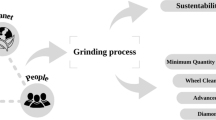Abstract
Grinding processes are applied to achieve a superior workpiece surface quality and accuracy. In order to fulfill these requirements efficiently, the use of cutting fluid is indispensable. However, during the grinding process, the application of cutting fluids leads to the formation of cutting fluid emissions. These emissions can have a negative impact on the workers’ health, can be explosive, and can result into the drag-out of cutting fluid. This paper presents an experimental approach to evaluate the influence of process parameters on the formation of emissions and the particle size. It reveals a linear influence of cutting speed and cutting fluid volume flow rate as well as a significant impact of the material removal process.
Similar content being viewed by others
References
Herrmann C, Madanchi N, Winter M, Öhlschläger G, Greßmann A, Zettl E, Schwengers K, Lange U (2017) Ökologische und ökonomische Bewertung des Ressourcenaufwands - Wassermischbare Kühlschmierstoffe. VDI Zentrum Ressourceneffizienz GmbH, Berlin
Deutsche Gesetzliche Unfallversichung e.V (2011) Tätigkeiten mit Kühlschmierstoffen, Deutsch Gesetzliche Unfallversichung e.V. Medienproduktion, Berlin
Winter M (2016) Eco-efficiency of grinding processes and systems. Dr.-Ing. Dissertation. Technische Universität Braunschweig, Springer International Publishing
Petuelli G (2002) Simulation des Kühlschmierstoffkreislaufs zur Optimierung einer umwelt- und ressourcenschonenden Produktionstechnik. Shaker Verlag GmbH, Aachen
Frost T (2008) Drehen mit geschlossenem Innenkühlsystem. Berichte aus dem Produktionstechnischen Zentrum Berlin. Hrsg.: Uhlmann, E. Dr.-Ing. Dissertation. Technische Universität Berlin. Stuttgart: Fraunhofer IRB
Klocke F, König W (2011) Manufacturing processes 1 – cutting. Springer Verlag, Berlin, Heidelberg
Denkena B, Tönshoff H (2011) Spanen – Grundlagen. Springer Verlag, Wiesbaden
Li K, Aghazadeh F, Hatipkarasulu RT (2003) Health risks from exposure to metal-working fluids in machining and grinding operations. Int J Occup Saf Ergon 1(/9):75–95
DIN 51385 (2013) Schmierstoffe – Bearbeitungsmedien für die Umformung und Zerspanung von Werkstoffen. Deutsches Institut für Normung e.V. German. Beuth Verlag GmbH, Berlin
Debnath S, Reddy MM, Sok Yi Q (2014) Environmental friendly cutting fluids and cooling techniques in machining: a review. J Clean Prod 83:33–47
American meteorological society (2012) Particle. http://glossary.ametsoc.org/wiki/Particle. Accessed 16 Mar 2018
Lazaridis M, Colbeck I (2014) Aerosol science: technology and applications. Wiley, Chichester
Bell D, Chou J, Nowag L, Liang Y (1999) Modeling the environment impacts of cutting fluid. Tribol Trans 42/1:168–173
Gunter K, Sutherland J (1999) An experimental investigation into the effect of process conditions on the mass concentration of cutting fluid mist in turning. J Clean Prod 7(5):341–350
Madanchi N, Winter M, Herrmann C (2015) Cutting fluid drag-out and exhaust air in grinding processes: influence on the eco-efficiency. In: Proceedings of the 22th CIRP conference on life cycle engineering, The University of New South Wales, Sydney, Australia, 329–334
Technische Regeln für Gefahrstoffe (TRGS) 900 (2000) Arbeitsplatzgrenzwerte in der Luft am Arbeitsplatz „Luftgrenzwerte”. Bundesanstalt für Arbeitsschutz und Arbeitsmedizin, Ausschuss für Gefahrstoffe, Dortmund
Bannert P, Michels P (2007) Lufttechnische Maßnahmen bei Tätigkeiten mit Kühlschmierstoffen, Berufsgenossenschaft der Feinmechanik und Elektrotechnik, Köln
Technische Regeln für Gefahrstoffe (TRGS) 900 (2006) Arbeitsplatzgrenzwerte in der Luft am Arbeitsplatz „Luftgrenzwerte”. Bundesanstalt für Arbeitsschutz und Arbeitsmedizin, Ausschuss für Gefahrstoffe, Dortmund
United States Occupational Safety and Health Administration (1989) 1910.1000 Table Z-1: table Z-1 limit for air contaminants, United States Department of Labor
Heyder J, Gebhart J, Rudolf G, Schiller CF, Stahlhofen W (1986) Deposition of particles in the human respiratory tract in the size range of 0.005 – 15 μm. J Aerosol Sci 17:811–825
Nesaratnam S, Taherzadeh S (2004) Air quality management. Wiley, Chichester
International Commission for Radiological Protection (ICRP) (1994) ICRP model: human respiratory tract model for radiological protection. ICRP Publication 66:1–482
Peters A, Wichmann E, Tuch T, Heinrich J, Heyder J (1997) Respiratory effects are associated with the number of ultrafine particles. Am J Respir Crit Care Med 155:1376–1383
Author information
Authors and Affiliations
Corresponding author
Electronic supplementary material
ESM 1
(PDF 121 kb)
Rights and permissions
About this article
Cite this article
Madanchi, N., Leiden, A., Winter, M. et al. Cutting fluid emissions in grinding processes: influence of process parameters on particle size and mass concentration. Int J Adv Manuf Technol 101, 773–783 (2019). https://doi.org/10.1007/s00170-018-2934-5
Received:
Accepted:
Published:
Issue Date:
DOI: https://doi.org/10.1007/s00170-018-2934-5



